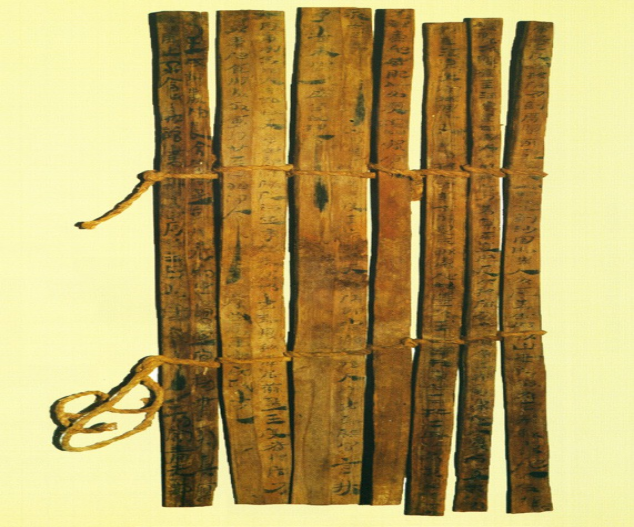
The Oficial Document Regarding the Investigation of the Camels Presented by the Kangju Envoy
In 1990, the document, The Oficial Document Regarding the Investigation of the Camels Presented by the Kangju Envoy (Slip No. II90DXT0216 ② : 877-883), was unearthed at the Xuanquan Posthouse Site. It was found with its binding intact and consists of seven slips. The first four slips contain appeal letters from Yang Bodao and other envoys of the king of the State of Kangju, while the last three slips are investigation documents from various levels.
The records detail an incident in 39 BC during the Western Han Dynasty, in which the envoy from the State of Kangju reported that camels presented to the Han emperor had changed from white to yellow and from fat to thin. This diplomatic dispute caused the Han-dynasty officials to jointly issue a directive mandating an investigation in Dunhuang Prefecture. Through this diplomatic dispute, the document reveals the process and manner of interactions between the Han Dynasty and the State of Kangju in the Western Regions, serving as a typical example of ethnic communication and exchanges.
After the trailblazing of the Silk Road, interactions between the Western Regions and the Central Plains became frequent. Records from the Han-dynasty bamboo slips of the Xuanquan Posthouse Site indicate that kings, nobles, and envoys from various Western Regions states traveled to the Central Plains. During the reign of Emperor Xuandi, Xuanquan Posthouse hosted envoys, hostages, and nobles from nine Western Regions states in two waves within a single month. The Han-dynasty's postal system provided food, transportation, and accommodation for these guests, ensuring their safe passage to Chang'an. The simultaneous arrival of visitors from various Western Regions states at Xuanquan Posthouse suggests a harmonious coexistence among the Western Regions along the Silk Road during this period. In addition to the prized horses highly valued by the Han Dynasty, contributes included lions sent by the envoy of the King of Zheyuan and camels by the King of Kangju. This exchange facilitated the introduction of a wide variety of goods from the Western Regions into the Central Plains through Dunhuang during this time.
《案驗康居王使者獻駝冊》
1990年,敦煌懸泉置遺址發掘出土的《案驗康居王使者獻駝冊》(簡牘編號Ⅱ 90DXT0216 ② : 877—883),出土時編繩完整,全文由7簡組成,前4簡是康居王使者楊伯刀等人的申訴文書,后3簡是各級調查文書。
文書記錄了西漢元帝永光五年(前39),康居王使者送給漢朝皇帝的駱駝由白色變黃色、由肥變瘦的申訴。這一外事糾紛事件,由漢朝中央主管“使主客諫大夫漢、侍郎當”聯合下文給敦煌郡進行調查。全文借由外事糾紛,反映出漢與西域康居國的交往過程和交往方式,是中西交通、民族交往的典型范例。
在絲綢之路開通之后,西域與中原的交往頻繁。從懸泉漢簡的記錄中,可以看到西域各國國王、貴人和使者前往中原的記錄。漢宣帝時懸泉置曾在一個月內分兩批接待了西域9個國家的質子、貴人和使者,漢朝的郵驛為西域的客人們提供飲食車馬接待,并派人迎送他們到長安。西域諸國的來客同時出現在懸泉置,也足以說明當時絲綢之路上的西域各國和睦相處。而貢獻的物品除了漢王朝重視的良馬外,還有折垣王派使者貢獻的獅子,康居王派人貢獻的駱駝,從而使這一時期西域的大量物產經過敦煌傳入中原。

